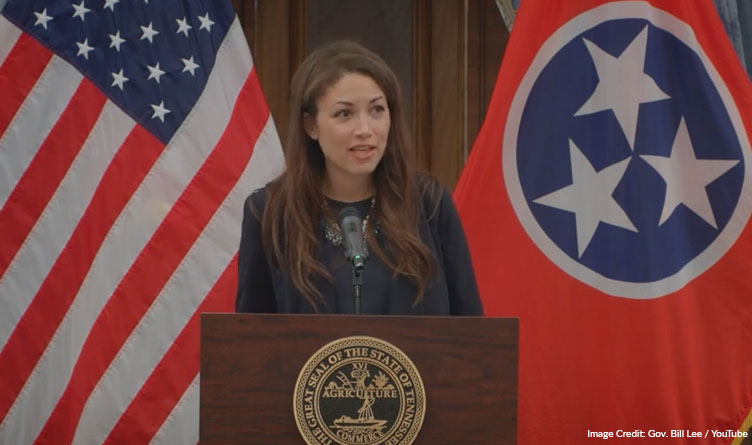Image Credit: Gov. Bill Lee / YouTube
The Center Square [By Jon Styf] –
Every Tennessee school district received a projection from the state this week showing how much funding the district would receive during the 2023-24 school year if a new public school funding formula is approved.
The student-based funding formula starts with a base of $6,860 in funding for each student before adding weights for certain economic and achievement factors, or special needs, to arrive at the dollar amount each district would receive for a student.
Department of Education Commissioner Penny Schwinn said school districts would receive more funding in the new formula than they currently receive if enrollment in a public school remains the same, starting in the 2023-24 school year.
Overall, $9 billion from state and local governments would be distributed in the formula during the 2023-24 school year for the state’s approximately 1 million public school students.
Part of the goal in the new funding model, Gov. Bill Lee and Schwinn said, is to simplify the process and allow the funding model and outcomes to be publicly available. The district sheets start with the $6,860 base cost and have separate lines for each of the added weights.
*** Click Here to Support Conservative Journalism in Tennessee. We can’t bring you stories like this without your support!***
A student who is considered economically disadvantaged, which includes one-third of the students in the state, would receive an additional $1,715 with students living in areas of concentrated poverty, two-thirds of the state’s students, receiving $343 more.
The largest potential funding increases are for students with unique learning needs related to disabilities. Those students would receive between $1,029 and $10,290 in additional funding to their school district. There are more than 288,000 students in the state who would receive a unique learning needs bonus.
While those funding dollars are attached to an individual student, all of the funds would go to a local school district, which would distribute and spend the money as it chooses.
The state also would send districts an average of $5,000 for students involved in career and technical education (CTE) programs, which currently includes 42,000 students in Tennessee. The goal of that bonus is to increase incentives for important fields of study in the state, Lee said.
The $100 million in the formula for outcomes-based funding, for items such as ACT scores and Tier II or Tier III industry credentials in CTE, would be sent to a district after the achievement is reached as a bonus the district can spend as it chooses, Schwinn said.
The state also would send additional funds to districts that add 2% in enrollment for three consecutive years, allowing those districts to have those funds for necessary infrastructure additions to accommodate the enrollment increase.
The new funding formula also would increase minimum teacher salaries, with a goal of having a $45,000 minimum by 2026, an increase from the $35,000 minimum salary in 2019.
One concern brought up by lawmakers, such as Sen. Heidi Campbell, D-Nashville, is the addition of public charter schools affiliated with Michigan’s Hillsdale College. Lee announced a partnership with Hillsdale during this year’s state of the state address.
Schwinn said those schools would receive public-school funding just like traditional public schools based on the new formula.
“It’s most important to remember that public schools are charter schools, charter schools are public schools,” Lee said.
The new school funding legislation is the result of a process that began in October, which included 18 subcommittees, public meetings and an overall steering committee looking to replace the current Basic Education Program (BEP) funding formula, created in 1992, with a modernized approach.
“While we are still delving into the details of the amendment, what we know so far is consistent with our recommendations to date,” said Ron Shultis, director of policy at Beacon Impact, an advocacy arm of the Beacon Center of Tennessee. “We applaud Gov. Lee for making student-based funding a top priority. It’s time we fund students, not systems, and we believe this proposal will make that possible.”
The language for the new formula will be added as amendments to companion bills that are assigned to the Senate Education Committee and House K-12 Subcommittee.
“There is a lot of work to be done, but there are weeks ahead and multiple committees ahead in the process,” Lee said. “We are certainly hopeful that this can be accomplished in this session.”


About the Author: Jon Styf, The Center Square Staff Reporter – Jon Styf is an award-winning editor and reporter who has worked in Illinois, Texas, Wisconsin, Florida and Michigan in local newsrooms over the past 20 years, working for Shaw Media, Hearst and several other companies. Follow Jon on Twitter @JonStyf.




One Response
How can anyone come up with such numbers to teach one child? This is totally nuts. This funding is crazy. There is no way it takes that kind of money to teach a child. Quit feeding, 3 meals a day. Let parents have the responsibility of feeding their children. The only schools do with money is buy politicians. They need to teach children. Since that is not going to happen maybe parents need to HOME SCHOOL.